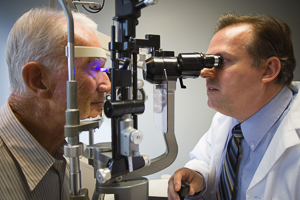Glaucoma: Target Eye Pressure
Current as of: December 3, 2017

In the treatment of glaucoma, your eye doctor will try to reduce the risk of damage to your optic nerve by keeping your eye pressure (intraocular pressure, or IOP) from rising above a certain level. That level of pressure is called your target pressure. By reducing the risk of optic nerve damage, maintaining the target pressure in your eyes may help slow the progression of the disease.
A tonometry test is used to measure the pressure in the eyes. The target pressure is based on the degree of optic nerve damage, the amount of visual field loss and, to a lesser degree, the initial pressure in the eye and how widely it varies each time it is measured. The target pressure varies from person to person. It is usually about 20% to 30% less than the highest IOP you've had.
When the tonometry measurement is above target pressure, your doctor will consider making changes to your treatment, such as starting medicine, changing your medicine, or talking with you about options for surgery.
ByHealthwise Staff
Primary Medical Reviewer Adam Husney, MD - Family Medicine
E. Gregory Thompson, MD - Internal Medicine
Specialist Medical Reviewer Christopher Joseph Rudnisky, MD, MPH, FRCSC - Ophthalmology
Current as ofDecember 3, 2017
Next Section:
Related InformationPrevious Section:
Topic OverviewNext Section:
CreditsPrevious Section:
Related InformationCurrent as of: December 3, 2017
This information does not replace the advice of a doctor. Healthwise, Incorporated, disclaims any warranty or liability for your use of this information. Your use of this information means that you agree to the Terms of Use. Learn how we develop our content.
To learn more about Healthwise, visit Healthwise.org.
© 1995-2018 Healthwise, Incorporated. Healthwise, Healthwise for every health decision, and the Healthwise logo are trademarks of Healthwise, Incorporated.